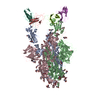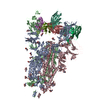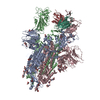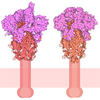+ データを開く
データを開く
- 基本情報
基本情報
| 登録情報 | データベース: PDB / ID: 9ml4 | |||||||||
|---|---|---|---|---|---|---|---|---|---|---|
| タイトル | Structure of the SARS-CoV-2 Spike 6P in complex with the rabbit M8b-A10 Fab | |||||||||
 要素 要素 |
| |||||||||
 キーワード キーワード | VIRAL PROTEIN/IMMUNE SYSTEM / immune system / neutralizing antibody / IMMUNE SYSTEM-VIRAL PROTEIN complex / VIRAL PROTEIN-IMMUNE SYSTEM complex | |||||||||
| 機能・相同性 |  機能・相同性情報 機能・相同性情報Maturation of spike protein / viral translation / Translation of Structural Proteins / Virion Assembly and Release / host cell surface / host extracellular space / symbiont-mediated-mediated suppression of host tetherin activity / Induction of Cell-Cell Fusion / structural constituent of virion / entry receptor-mediated virion attachment to host cell ...Maturation of spike protein / viral translation / Translation of Structural Proteins / Virion Assembly and Release / host cell surface / host extracellular space / symbiont-mediated-mediated suppression of host tetherin activity / Induction of Cell-Cell Fusion / structural constituent of virion / entry receptor-mediated virion attachment to host cell / membrane fusion / Attachment and Entry / host cell endoplasmic reticulum-Golgi intermediate compartment membrane / positive regulation of viral entry into host cell / receptor-mediated virion attachment to host cell / host cell surface receptor binding / symbiont-mediated suppression of host innate immune response / receptor ligand activity / endocytosis involved in viral entry into host cell / fusion of virus membrane with host plasma membrane / fusion of virus membrane with host endosome membrane / viral envelope / virion attachment to host cell / SARS-CoV-2 activates/modulates innate and adaptive immune responses / host cell plasma membrane / virion membrane / identical protein binding / membrane / plasma membrane 類似検索 - 分子機能 | |||||||||
| 生物種 |   | |||||||||
| 手法 | 電子顕微鏡法 / 単粒子再構成法 / クライオ電子顕微鏡法 / 解像度: 3.3 Å | |||||||||
 データ登録者 データ登録者 | Fan, C. / Bjorkman, P.J. | |||||||||
| 資金援助 |  米国, 2件 米国, 2件
| |||||||||
 引用 引用 |  ジャーナル: Proc Natl Acad Sci U S A / 年: 2025 ジャーナル: Proc Natl Acad Sci U S A / 年: 2025タイトル: Cross-reactive sarbecovirus antibodies induced by mosaic RBD nanoparticles. 著者: Chengcheng Fan / Jennifer R Keeffe / Kathryn E Malecek / Alexander A Cohen / Anthony P West / Viren A Baharani / Annie V Rorick / Han Gao / Priyanthi N P Gnanapragasam / Semi Rho / Jaasiel ...著者: Chengcheng Fan / Jennifer R Keeffe / Kathryn E Malecek / Alexander A Cohen / Anthony P West / Viren A Baharani / Annie V Rorick / Han Gao / Priyanthi N P Gnanapragasam / Semi Rho / Jaasiel Alvarez / Luisa N Segovia / Theodora Hatziioannou / Paul D Bieniasz / Pamela J Bjorkman /  要旨: Broad immune responses are needed to mitigate viral evolution and escape. To induce antibodies against conserved receptor-binding domain (RBD) regions of SARS-like betacoronavirus (sarbecovirus) ...Broad immune responses are needed to mitigate viral evolution and escape. To induce antibodies against conserved receptor-binding domain (RBD) regions of SARS-like betacoronavirus (sarbecovirus) spike proteins that recognize SARS-CoV-2 variants of concern and zoonotic sarbecoviruses, we developed mosaic-8b RBD nanoparticles presenting eight sarbecovirus RBDs arranged randomly on a 60-mer nanoparticle. Mosaic-8b immunizations protected animals from challenges from viruses whose RBDs were matched or mismatched to those on nanoparticles. Here, we describe neutralizing mAbs isolated from mosaic-8b-immunized rabbits, some on par with Pemgarda, the only currently FDA-approved therapeutic mAb. Deep mutational scanning, in vitro selection of spike resistance mutations, and single-particle cryo-electron microscopy structures of spike-antibody complexes demonstrated targeting of conserved RBD epitopes. Rabbit mAbs included critical D-gene segment RBD-recognizing features in common with human anti-RBD mAbs, despite rabbit genomes lacking an equivalent human D-gene segment, thus demonstrating that the immune systems of humans and other mammals can utilize different antibody gene segments to arrive at similar modes of antigen recognition. These results suggest that animal models can be used to elicit anti-RBD mAbs with similar properties to those raised in humans, which can then be humanized for therapeutic use, and that mosaic RBD nanoparticle immunization coupled with multiplexed screening represents an efficient way to generate and select broadly cross-reactive therapeutic pan-sarbecovirus and pan-SARS-CoV-2 variant mAbs. | |||||||||
| 履歴 |
|
- 構造の表示
構造の表示
| 構造ビューア | 分子:  Molmil Molmil Jmol/JSmol Jmol/JSmol |
|---|
- ダウンロードとリンク
ダウンロードとリンク
- ダウンロード
ダウンロード
| PDBx/mmCIF形式 |  9ml4.cif.gz 9ml4.cif.gz | 919.2 KB | 表示 |  PDBx/mmCIF形式 PDBx/mmCIF形式 |
|---|---|---|---|---|
| PDB形式 |  pdb9ml4.ent.gz pdb9ml4.ent.gz | 599.8 KB | 表示 |  PDB形式 PDB形式 |
| PDBx/mmJSON形式 |  9ml4.json.gz 9ml4.json.gz | ツリー表示 |  PDBx/mmJSON形式 PDBx/mmJSON形式 | |
| その他 |  その他のダウンロード その他のダウンロード |
-検証レポート
| アーカイブディレクトリ |  https://data.pdbj.org/pub/pdb/validation_reports/ml/9ml4 https://data.pdbj.org/pub/pdb/validation_reports/ml/9ml4 ftp://data.pdbj.org/pub/pdb/validation_reports/ml/9ml4 ftp://data.pdbj.org/pub/pdb/validation_reports/ml/9ml4 | HTTPS FTP |
|---|
-関連構造データ
| 関連構造データ |  48347MC  9ml5C  9ml6C  9ml7C  9ml8C  9ml9C M: このデータのモデリングに利用したマップデータ C: 同じ文献を引用 ( |
|---|---|
| 類似構造データ | 類似検索 - 機能・相同性  F&H 検索 F&H 検索 |
- リンク
リンク
- 集合体
集合体
| 登録構造単位 | 
|
|---|---|
| 1 |
|
- 要素
要素
| #1: タンパク質 | 分子量: 139344.438 Da / 分子数: 3 / 変異: F817P, A892P, A899P, A942P, K986P, V987P / 由来タイプ: 組換発現 由来: (組換発現)  遺伝子: S, 2 / 発現宿主:  Homo sapiens (ヒト) / 参照: UniProt: P0DTC2 Homo sapiens (ヒト) / 参照: UniProt: P0DTC2#2: タンパク質 | 分子量: 23624.455 Da / 分子数: 3 / 由来タイプ: 組換発現 / 由来: (組換発現)   Homo sapiens (ヒト) Homo sapiens (ヒト)#3: 抗体 | 分子量: 23103.348 Da / 分子数: 3 / 由来タイプ: 組換発現 / 由来: (組換発現)   Homo sapiens (ヒト) Homo sapiens (ヒト)#4: 糖 | ChemComp-NAG / 研究の焦点であるリガンドがあるか | Y | Has protein modification | Y | |
|---|
-実験情報
-実験
| 実験 | 手法: 電子顕微鏡法 |
|---|---|
| EM実験 | 試料の集合状態: PARTICLE / 3次元再構成法: 単粒子再構成法 |
- 試料調製
試料調製
| 構成要素 |
| ||||||||||||||||||||||||||||
|---|---|---|---|---|---|---|---|---|---|---|---|---|---|---|---|---|---|---|---|---|---|---|---|---|---|---|---|---|---|
| 分子量 |
| ||||||||||||||||||||||||||||
| 由来(天然) |
| ||||||||||||||||||||||||||||
| 由来(組換発現) |
| ||||||||||||||||||||||||||||
| 緩衝液 | pH: 8 | ||||||||||||||||||||||||||||
| 緩衝液成分 |
| ||||||||||||||||||||||||||||
| 試料 | 濃度: 2 mg/ml / 包埋: NO / シャドウイング: NO / 染色: NO / 凍結: YES | ||||||||||||||||||||||||||||
| 試料支持 | グリッドのタイプ: Quantifoil R1.2/1.3 | ||||||||||||||||||||||||||||
| 急速凍結 | 装置: FEI VITROBOT MARK IV / 凍結剤: ETHANE / 湿度: 100 % / 凍結前の試料温度: 293 K |
- 電子顕微鏡撮影
電子顕微鏡撮影
| 実験機器 |  モデル: Titan Krios / 画像提供: FEI Company |
|---|---|
| 顕微鏡 | モデル: TFS KRIOS |
| 電子銃 | 電子線源:  FIELD EMISSION GUN / 加速電圧: 300 kV / 照射モード: FLOOD BEAM FIELD EMISSION GUN / 加速電圧: 300 kV / 照射モード: FLOOD BEAM |
| 電子レンズ | モード: BRIGHT FIELD / 倍率(公称値): 105000 X / 最大 デフォーカス(公称値): 3000 nm / 最小 デフォーカス(公称値): 1000 nm / Cs: 2.7 mm / アライメント法: COMA FREE |
| 試料ホルダ | 凍結剤: NITROGEN 試料ホルダーモデル: FEI TITAN KRIOS AUTOGRID HOLDER |
| 撮影 | 平均露光時間: 1.5 sec. / 電子線照射量: 60 e/Å2 フィルム・検出器のモデル: GATAN K3 BIOQUANTUM (6k x 4k) 実像数: 6777 |
- 解析
解析
| EMソフトウェア |
| ||||||||||||||||||||||||||||||||||||||||
|---|---|---|---|---|---|---|---|---|---|---|---|---|---|---|---|---|---|---|---|---|---|---|---|---|---|---|---|---|---|---|---|---|---|---|---|---|---|---|---|---|---|
| CTF補正 | タイプ: PHASE FLIPPING AND AMPLITUDE CORRECTION | ||||||||||||||||||||||||||||||||||||||||
| 粒子像の選択 | 選択した粒子像数: 950884 | ||||||||||||||||||||||||||||||||||||||||
| 対称性 | 点対称性: C1 (非対称) | ||||||||||||||||||||||||||||||||||||||||
| 3次元再構成 | 解像度: 3.3 Å / 解像度の算出法: FSC 0.143 CUT-OFF / 粒子像の数: 134713 / 対称性のタイプ: POINT | ||||||||||||||||||||||||||||||||||||||||
| 原子モデル構築 | B value: 90 / プロトコル: RIGID BODY FIT / 空間: REAL | ||||||||||||||||||||||||||||||||||||||||
| 原子モデル構築 |
| ||||||||||||||||||||||||||||||||||||||||
| 精密化 | 交差検証法: NONE 立体化学のターゲット値: GeoStd + Monomer Library + CDL v1.2 | ||||||||||||||||||||||||||||||||||||||||
| 原子変位パラメータ | Biso mean: 182.15 Å2 | ||||||||||||||||||||||||||||||||||||||||
| 拘束条件 |
|
 ムービー
ムービー コントローラー
コントローラー






 PDBj
PDBj









